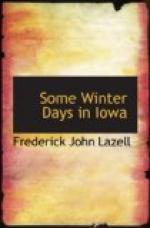The stillness is a marked contrast to the recent roar of the winds. You may hear your watch ticking in your pocket. The leisurely tapping of a downy woodpecker sounds like the ticking of a clock in a vast ancestral hall. You may actually hear a squirrel running down a tree, twenty rods away. He paws out an acorn and begins to eat. The noise of your footstep seems like a profanation of holy ground. Also it disturbs the squirrel who scurries up to the topmost twigs of an elm nearly a hundred feet high. With a glass you may see his eyes shine as he watches you. His long red tail hangs down still and straight and there is not breeze enough, even up there, to stir it.
Gnats and moths flit in the soft sunlight and spiders run over tree trunks while their single shining lines of silk are stretched among the hazel.
Anon the bird chorus breaks out, full and strong. The winter birds report all present but there are a number of new voices, especially the warble of the robin, the tremulous, confiding “sol-si, sol-si” of the bluebird and the clear call of the phoebe. The robins are thick down in the birch swamps, on the islands among the last year’s knot-weed. You may tell them at a distance by their trim, military manner of walking, and if you wish you may get close enough to them to take their complete description. And, by the way, how many can describe this common bird, the color of his head and bill, his back and tail, and the exact shade of his breast. Is there any white on him, and if so, where?
After the ice is out of the rivers the bird-lover is kept busy. In the early sunny morning the duet of the robins and the meadow larks is better than breakfast. March usually gives us the hermit thrush and the ruby-and golden-crowned kinglets; the song, field, fox, white throated, Savannah and Lincoln sparrows; the meadow lark, the bronzed grackle and the cowbird; the red-winged, the yellow-head and the rusty blackbirds; the wood pewee and the olive-sided flycatcher; the flicker and the sap-sucker, the mourning dove and several of the water fowl. Last week—the first week in March—a golden eagle paused in his migration to sit awhile on a fence post at the side of a timber road. Two men got near enough to see the color of his feathers and then one of them, with a John Burroughs instinct, took a shot at him. He missed; there was a spread of the great wings and the big bird resumed his journey northward.
* * * * *
By the shallow creek which ripples over the many-hued gravel there is much of interest. The frog sits on the bank as we approach and goes into the water with a splash. In the quiet little bayous the minnows are lively, and tracks upon the soft mud show that the mink has been watching them. A pile of neatly cleaned clam shells is evidence that the muskrat has had a feast. There is a huge clam, partly opened, at arm’s length from the shore. We fish it out and pry it open farther; out comes the remains of the esculent clam, and we almost jump when it is followed by a live and healthy crawfish.




